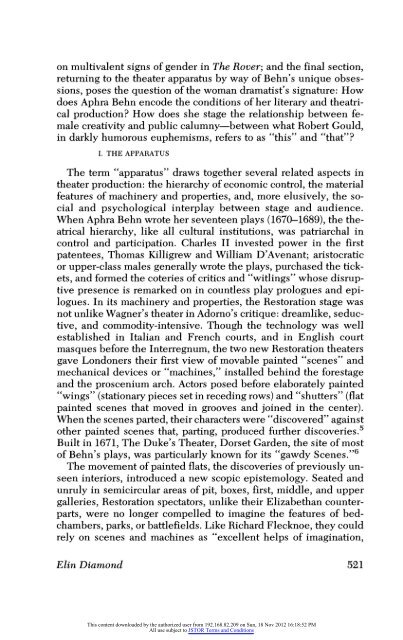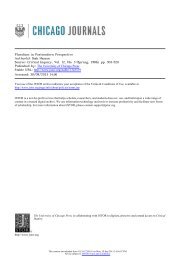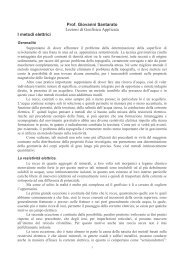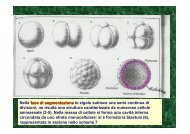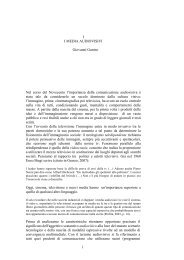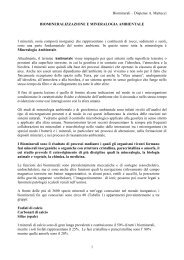Gestus and Signature in Aphra Behn's the Rover
Gestus and Signature in Aphra Behn's the Rover
Gestus and Signature in Aphra Behn's the Rover
You also want an ePaper? Increase the reach of your titles
YUMPU automatically turns print PDFs into web optimized ePapers that Google loves.
on multivalent signs of gender <strong>in</strong> The <strong>Rover</strong>; <strong>and</strong> <strong>the</strong> f<strong>in</strong>al section,<br />
return<strong>in</strong>g to <strong>the</strong> <strong>the</strong>ater apparatus by way of <strong>Behn's</strong> unique obses-<br />
sions, poses <strong>the</strong> question of <strong>the</strong> woman dramatist's signature: How<br />
does <strong>Aphra</strong> Behn encode <strong>the</strong> conditions of her literary <strong>and</strong> <strong>the</strong>atri-<br />
cal production? How does she stage <strong>the</strong> relationship between fe-<br />
male creativity <strong>and</strong> public calumny-between what Robert Gould,<br />
<strong>in</strong> darkly humorous euphemisms, refers to as "this" <strong>and</strong> "that"?<br />
I. THE APPARATUS<br />
The term "apparatus" draws toge<strong>the</strong>r several related aspects <strong>in</strong><br />
<strong>the</strong>ater production: <strong>the</strong> hierarchy of economic control, <strong>the</strong> material<br />
features of mach<strong>in</strong>ery <strong>and</strong> properties, <strong>and</strong>, more elusively, <strong>the</strong> social<br />
<strong>and</strong> psychological <strong>in</strong>terplay between stage <strong>and</strong> audience.<br />
When <strong>Aphra</strong> Behn wrote her seventeen plays (1670-1689), <strong>the</strong> <strong>the</strong>atrical<br />
hierarchy, like all cultural <strong>in</strong>stitutions, was patriarchal <strong>in</strong><br />
control <strong>and</strong> participation. Charles II <strong>in</strong>vested power <strong>in</strong> <strong>the</strong> first<br />
patentees, Thomas Killigrew <strong>and</strong> William D'Avenant; aristocratic<br />
or upper-class males generally wrote <strong>the</strong> plays, purchased <strong>the</strong> tickets,<br />
<strong>and</strong> formed <strong>the</strong> coteries of critics <strong>and</strong> "witl<strong>in</strong>gs" whose disruptive<br />
presence is remarked on <strong>in</strong> countless play prologues <strong>and</strong> epilogues.<br />
In its mach<strong>in</strong>ery <strong>and</strong> properties, <strong>the</strong> Restoration stage was<br />
not unlike Wagner's <strong>the</strong>ater <strong>in</strong> Adorno's critique: dreamlike, seductive,<br />
<strong>and</strong> commodity-<strong>in</strong>tensive. Though <strong>the</strong> technology was well<br />
established <strong>in</strong> Italian <strong>and</strong> French courts, <strong>and</strong> <strong>in</strong> English court<br />
masques before <strong>the</strong> Interregnum, <strong>the</strong> two new Restoration <strong>the</strong>aters<br />
gave Londoners <strong>the</strong>ir first view of movable pa<strong>in</strong>ted "scenes" <strong>and</strong><br />
mechanical devices or "mach<strong>in</strong>es," <strong>in</strong>stalled beh<strong>in</strong>d <strong>the</strong> forestage<br />
<strong>and</strong> <strong>the</strong> proscenium arch. Actors posed before elaborately pa<strong>in</strong>ted<br />
"w<strong>in</strong>gs" (stationary pieces set <strong>in</strong> reced<strong>in</strong>g rows) <strong>and</strong> "shutters" (flat<br />
pa<strong>in</strong>ted scenes that moved <strong>in</strong> grooves <strong>and</strong> jo<strong>in</strong>ed <strong>in</strong> <strong>the</strong> center).<br />
When <strong>the</strong> scenes parted, <strong>the</strong>ir characters were "discovered" aga<strong>in</strong>st<br />
o<strong>the</strong>r pa<strong>in</strong>ted scenes that, part<strong>in</strong>g, produced fur<strong>the</strong>r discoveries.5<br />
Built <strong>in</strong> 1671, The Duke's Theater, Dorset Garden, <strong>the</strong> site of most<br />
of <strong>Behn's</strong> plays, was particularly known for its "gawdy Scenes."6<br />
The movement of pa<strong>in</strong>ted flats, <strong>the</strong> discoveries of previously unseen<br />
<strong>in</strong>teriors, <strong>in</strong>troduced a new scopic epistemology. Seated <strong>and</strong><br />
unruly <strong>in</strong> semicircular areas of pit, boxes, first, middle, <strong>and</strong> upper<br />
galleries, Restoration spectators, unlike <strong>the</strong>ir Elizabethan counterparts,<br />
were no longer compelled to imag<strong>in</strong>e <strong>the</strong> features of bedchambers,<br />
parks, or battlefields. Like Richard Flecknoe, <strong>the</strong>y could<br />
rely on scenes <strong>and</strong> mach<strong>in</strong>es as "excellent helps of imag<strong>in</strong>ation,<br />
El<strong>in</strong> Diamond 521<br />
This content downloaded by <strong>the</strong> authorized user from 192.168.82.209 on Sun, 18 Nov 2012 16:18:52 PM<br />
All use subject to JSTOR Terms <strong>and</strong> Conditions


